|

 Explorers, Scientists &
Inventors
Explorers, Scientists &
Inventors
 Musicians, Painters &
Artists
Musicians, Painters &
Artists
 Poets, Writers &
Philosophers
Poets, Writers &
Philosophers
 Native Americans & The Wild
West
Native Americans & The Wild
West
 First Ladies
First Ladies
 Popes
Popes
 Troublemakers
Troublemakers
 Historians
Historians
 Archaeologists
Archaeologists
 Royal Families
Royal Families
 Tribes & Peoples
Tribes & Peoples

Assassinations in History
Who
got slain, almost slain, when, how,
why, and by whom?
 Go to the
Assassination Archive
Go to the
Assassination Archive

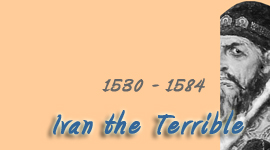


Online History Dictionary A - Z
All-Time Records in
History
What was the
bloodiest battle, the battle with the least
casualties, who was the greatest military leader?
 Go to
Records in History
Go to
Records in History
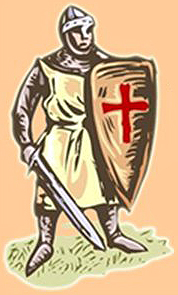
|
|
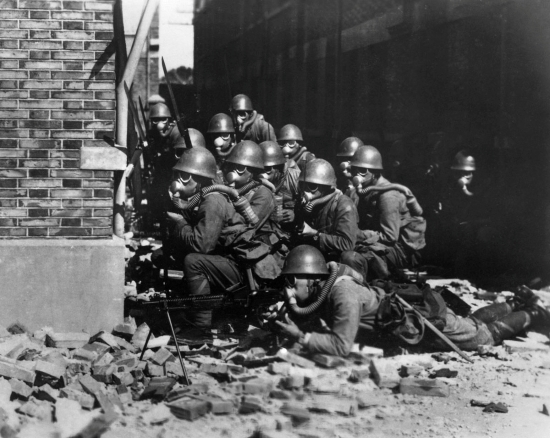
Japanese Soldiers in Shanghai, August 1937
Wiki / Kokusai Joho Sha
Second Sino-Japanese War 1937-1945
The Second Sino-Japanese War was fought because Japan's vision of a Japanese-dominated East Asia
collided with China's disapproval of being invaded.
|
|
This conflict eventually merged into the
 Pacific War
, which in turn was a major theater of
Pacific War
, which in turn was a major theater of
 World War II
.
(The Pacific War begun with the attack on Pearl Harbor in 1941.)
World War II
.
(The Pacific War begun with the attack on Pearl Harbor in 1941.)
Why Was the Second Sino-Japanese War Fought?
Japan faced resource limitations on its home islands and was driven by militaristic
leadership that pursued a strategy of continental expansion, which had already yielded the acquisition of Taiwan,
Korea, and Manchuria.
The immediate trigger came with the Marco Polo Bridge Incident of July 7, 1937, which Japan
exploited as a pretext for full-scale invasion, but this merely accelerated a conflict that had been building
through decades of Japanese encroachment and Chinese resistance.
Could the Second Sino-Japanese War Have Been Prevented?
Of note is the failure of international agreements to check earlier Japanese aggression.
-
The League of Nations, which was the predecessor to the United Nations and existed from 1920 to 1946, condemned
Japan's actions when Japan invaded Manchuria in 1931 and established the puppet state of Manchukuo, but took no effective
measures to stop the aggression. In response, Japan simply withdrew from the League in 1933.
-
The Washington Naval Treaty System was a series of international agreements reached at the Washington Naval
Conference (1921–1922), aimed at limiting naval armaments and stabilizing power dynamics in the Pacific and East Asia
after World War I.
-
At its core was the Five-Power Treaty (Washington Naval Treaty), which was signed by the United States,
Great Britain, Japan, France, and Italy. This treaty set strict limits on the number and tonnage of capital
ships (battleships and aircraft carriers) each power could possess, establishing a ratio of 5:5:3 for the
US, UK, and Japan respectively, with smaller allotments for France and Italy.
-
The Nine-Power Treaty was signed by the major powers plus China, the Netherlands, Belgium, and Portugal. It
committed the signatories to respect China's sovereignty and territorial integrity, effectively codifying
the "Open Door" policy and opposing further imperialist encroachments in China.
-
The Four-Power Treaty, which replaced the Anglo-Japanese Alliance with a broader security arrangement. The
US, UK, Japan, and France agreed to respect each other's Pacific territories and consult each other in the
event of a dispute.
-
The Washington System was extended by the London Naval Treaty of 1930, adding restrictions on cruisers,
destroyers, and submarines.
Japanese military expansionists increasingly viewed these treaties as unacceptable constraints on national power,
leading Japan to demand naval parity - that is, the right to have a navy equal in size and strength to
those of the United States and Britain - at the Second London Conference (1935) and, after being refused,
Japan withdrew entirely from
the treaty system in 1936.
|
Major Battles of the Second Sino-Japanese War
1937
Battle of Lugou Bridge (Marco Polo Bridge Incident) July 7, 1937: This marked the start of the war.
Battle of Shanghai (August 13 - November 26, 1937): A large-scale battle involving intense urban combat
with 10,000 Japanese troops launching attacks.
Battle of Nanjing: Resulted in the fall of Nanjing and the Nanjing Massacre, which began on
December 13, 1937, when Japanese troops captured Nanjing.
1938
Battle of Taiyuan (September 11 - November 9, 1937): Key battle in northern China.
Battle of Xuzhou: A major Chinese defensive effort.
Battle of Taierzhuang: A rare Chinese victory during the war.
Battle of Wuhan: One of the longest and largest battles, ending in Japanese victory.
1939
Battle of Nanchang: Japanese forces captured Nanchang.
Battle of Suixian-Zaoyang: Chinese counterattacks against Japanese advances.
First Battle of Changsha: A Chinese defensive success.
1940
Winter Offensive (1939-1940): A series of coordinated Chinese attacks.
1941
Second Battle of Changsha: Another successful defense by Chinese forces.
1942
Battle of Yunnan-Burma Road: Fought to secure supply routes to China.
1943
Battle of Changde: Known for fierce resistance and high casualties.
1944
Operation Ichi-Go: A massive Japanese offensive aimed at linking occupied territories.
Battle of West Henan-North Hubei (1944/45): Part of Operation Ichi-Go.
1945
Battle of West Hunan (Xiangxi Campaign): One of the final major battles, with a Chinese victory.
Outcome of the Second Sino-Japanese War
Strategicially, Japan’s prolonged occupation (1937–1945) strained its resources, diverting troops
and materiel needed for Pacific campaigns against Allied forces.
Japan formally surrendered on September 2, 1945, after the atomic bombings of Hiroshima and Nagasaki,
Soviet military intervention in Manchuria, and Allied advances in the Pacific Theater.
Taiwan
Japan's return of Taiwan was mandated by post-WWII agreements but remains politically contested.
In detail:
The Cairo Declaration (1943) and Potsdam Proclamation (1945) required Japan to return territories
seized from China, including Taiwan. Japan formally surrendered Taiwan in 1945 under General Order No. 1, with
ROC (Republic of China) representatives accepting the handover.
The Treaty of San Francisco (1951) and Treaty of Taipei (1952) finalized Japan’s renunciation of Taiwan
but did not specify a recipient, leaving sovereignty ambiguous. The ROC governed Taiwan from 1945 until the
Chinese Civil War forced its retreat there in 1949.
Today, the PRC (People's Republic of China) claims Taiwan as part of its territory under the "One China Principle,"
citing the 1945 handover, whereas the ROC (now based in Taiwan) maintains its own governance, with the island
operating as a de facto independent polity.
Historical Maps of the Second Sino-Japanese War
Here are the maps:

 1937 China - Chinese Territory Seized Prior to July 1937, Major Japanese Drives in 1937.
1937 China - Chinese Territory Seized Prior to July 1937, Major Japanese Drives in 1937.

 1938/39 China - Territory Occupied Prior to 1938. Japanese Advances in China During 1938 and 1939.
1938/39 China - Territory Occupied Prior to 1938. Japanese Advances in China During 1938 and 1939.

 1939-1945 World War
II: Major Operations in Asia and the Pacific
1939-1945 World War
II: Major Operations in Asia and the Pacific

 1939, September 1 -
World War II: The Far East and the Pacific.
The Imperial Powers.
1939, September 1 -
World War II: The Far East and the Pacific.
The Imperial Powers.

 1940 China - Japanese
Occupation
1940 China - Japanese
Occupation

 1941 China
1941 China
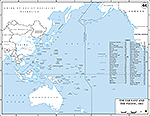
 1941 The Far East and
the Pacific (Two Maps, Political)
1941 The Far East and
the Pacific (Two Maps, Political)
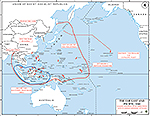
 1941, World War II:
The Far East and the Pacific. Major Japanese
War Objectives and Planned Opening Attacks.
1941, World War II:
The Far East and the Pacific. Major Japanese
War Objectives and Planned Opening Attacks.
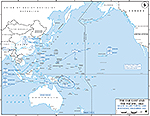
 1941, December: World
War II. The Far East and the Pacific. Major
Allied Forces and Positions.
1941, December: World
War II. The Far East and the Pacific. Major
Allied Forces and Positions.

 1941, December -
Southeast Asia in World War II: Japanese
Centrifugal Offensive.
1941, December -
Southeast Asia in World War II: Japanese
Centrifugal Offensive.
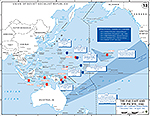
 1941, December 7
- April 18, 1942: World War II in the Far
East and the Pacific. American Carrier
Operations.
1941, December 7
- April 18, 1942: World War II in the Far
East and the Pacific. American Carrier
Operations.

 1941, December 7 -
March 12, 1942: World War II in the Far East
and the Pacific. Operations of the Japanese
First Air Fleet.
1941, December 7 -
March 12, 1942: World War II in the Far East
and the Pacific. Operations of the Japanese
First Air Fleet.
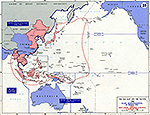
 1942, March 30: WWII
in the Far East and the Pacific. Allied
Reorganization, March 30, 1942. Area Under
Japanese Control, August 6, 1942.
1942, March 30: WWII
in the Far East and the Pacific. Allied
Reorganization, March 30, 1942. Area Under
Japanese Control, August 6, 1942.

 1942, July 2: World
War II in the Far East and the Pacific.
Status of Allied Forces and Theater
Boundaries.
1942, July 2: World
War II in the Far East and the Pacific.
Status of Allied Forces and Theater
Boundaries.
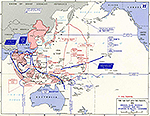
 1943, May: World War
II in the Far East and the Pacific. Original
Allied Strategic Concept, May 1943, and
Situation in the Pacific November 1, 1943.
1943, May: World War
II in the Far East and the Pacific. Original
Allied Strategic Concept, May 1943, and
Situation in the Pacific November 1, 1943.
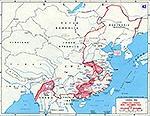
 1944, April - World
War II: China 1944. Operation ICHIGO, April
- December 1944. Situation December 31,
1944.
1944, April - World
War II: China 1944. Operation ICHIGO, April
- December 1944. Situation December 31,
1944.
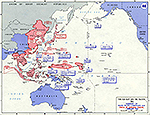
 1945, February 1 -
World War II in the Far East and the
Pacific. Summary of Allied Pacific
Campaigns. Status of Japanese Forces,
February 1, 1945.
1945, February 1 -
World War II in the Far East and the
Pacific. Summary of Allied Pacific
Campaigns. Status of Japanese Forces,
February 1, 1945.

 1945, August 15 -
World War II: The Far East and the Pacific.
Areas Under Allied and Japanese Control.
Situation August 15, 1945.
1945, August 15 -
World War II: The Far East and the Pacific.
Areas Under Allied and Japanese Control.
Situation August 15, 1945.
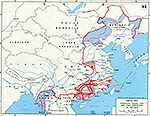
 1945 China. Operation
ICHIGO. Final Operations in the War.
1945 China. Operation
ICHIGO. Final Operations in the War.
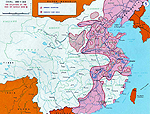
 1945 China - Situation
at the end of World War II
1945 China - Situation
at the end of World War II
Go here for the First Sino-Japanese War,
which was fought 1894-1895.
More History
|